Fundamentals of optimization#
ECON2125/6012 Lecture 6 Fedor Iskhakov
Announcements & Reminders
Test 1 results and discussion
Test 2 due date extended to Sept 6th (23:59)
Plan for this lecture
Open and closed sets (review)
Continuity of functions
Suprema and infima
Existence of optima
Uniqueness of optima
Supplementary reading:
Simon & Blume: 12.2, 12.3, 12.4, 12.5, 13.4, 29.2, 30.1
Sundaram: 1.2.6, 1.2.7, 1.2.8, 1.2.9, 1.2.10, 1.4.1, section 3
Sequences and limits in \(\mathbb{R}^K\)#
Definition: sequence
A sequence \(\{{\bf x}_n\}\) in \(\mathbb{R}^K\) is a function from \(\mathbb{N}\) to \(\mathbb{R}^K\)
Definition: Euclidean norm
The (Euclidean) norm of \({\bf x} \in \mathbb{R}^N\) is defined as
Interpretation:
\(\| {\bf x} \|\) represents the length of \({\bf x}\)
\(\| {\bf x} - {\bf y} \|\) represents distance between \({\bf x}\) and \({\bf y}\)
When \(K=1\), the norm \(\| \cdot \|\) reduces to \(|\cdot|\)
Definition
A set \(A \subset \mathbb{R}^K\) called bounded if
Definition
For \(\epsilon > 0\), the \(\epsilon\)-ball \(B_{\epsilon}({\bf a})\) around \({\bf a} \in \mathbb{R}^K\) is all \({\bf x} \in \mathbb{R}^K\) such that \(\|{\bf a} - {\bf x}\| < \epsilon\)
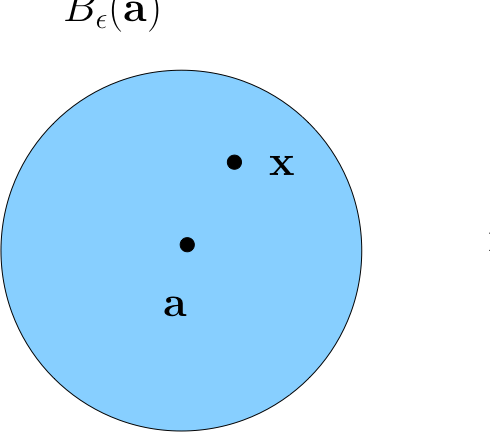
Fact
If \({\bf x}\) is in every \(\epsilon\)-ball around \({\bf a}\) then \({\bf x}={\bf a}\)
Fact
If \({\bf a} \ne {\bf b}\), then \(\exists \, \epsilon > 0\) such that \(B_\epsilon({\bf a}) \cap B_\epsilon({\bf b}) = \emptyset\)
Definition
Sequence \(\{{\bf x}_n\}\) is said to converge to \({\bf a} \in \mathbb{R}^K\) if
We say: “\(\{{\bf x}_n\}\) is eventually in any \(\epsilon\)-neighborhood of \({\bf a}\)”
In this case \({\bf a}\) is called the limit of the sequence, and we write
Definition
We call \(\{ {\bf x}_n \}\) convergent if it converges to some limit in \(\mathbb{R}^K\)

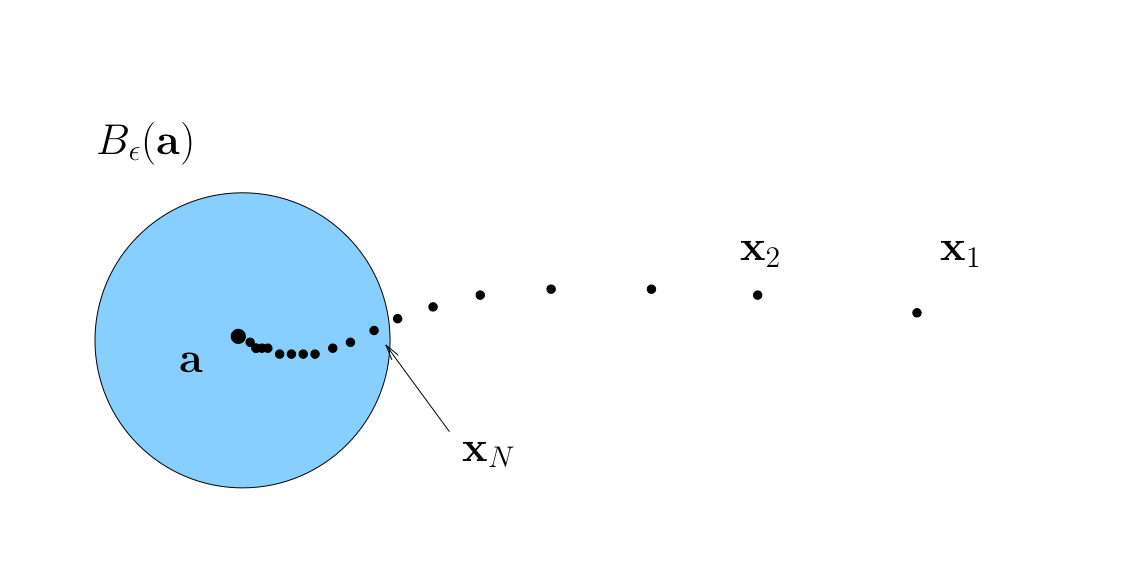
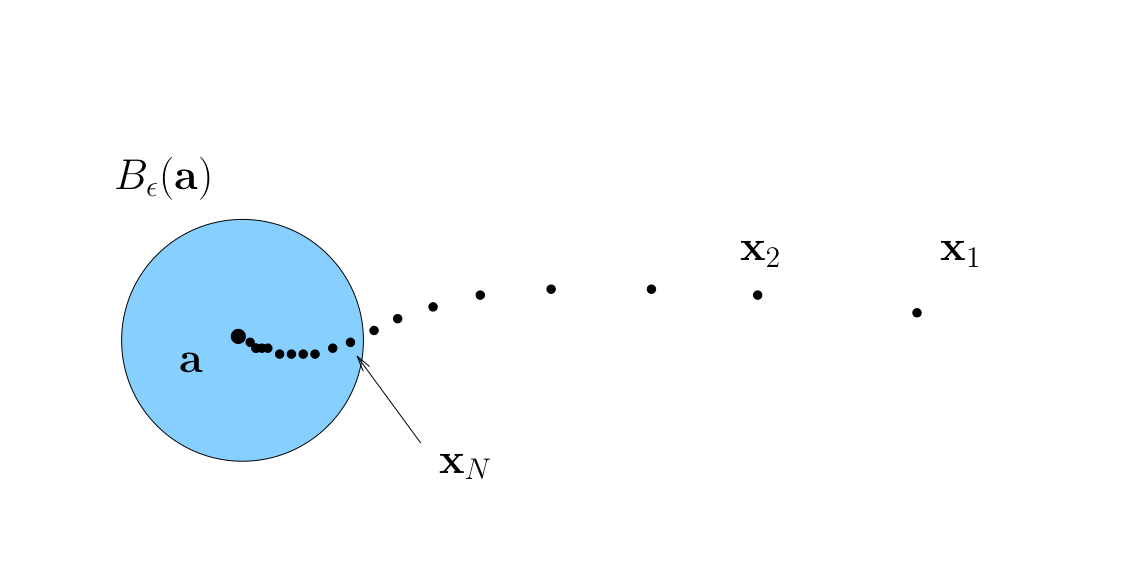
Fact
A sequence \(\{{\bf x}_n\}\) in \(\mathbb{R}^K\) converges to \({\bf a} \in \mathbb{R}^K\) if and only if each component sequence converges in \(\mathbb{R}\)
That is,
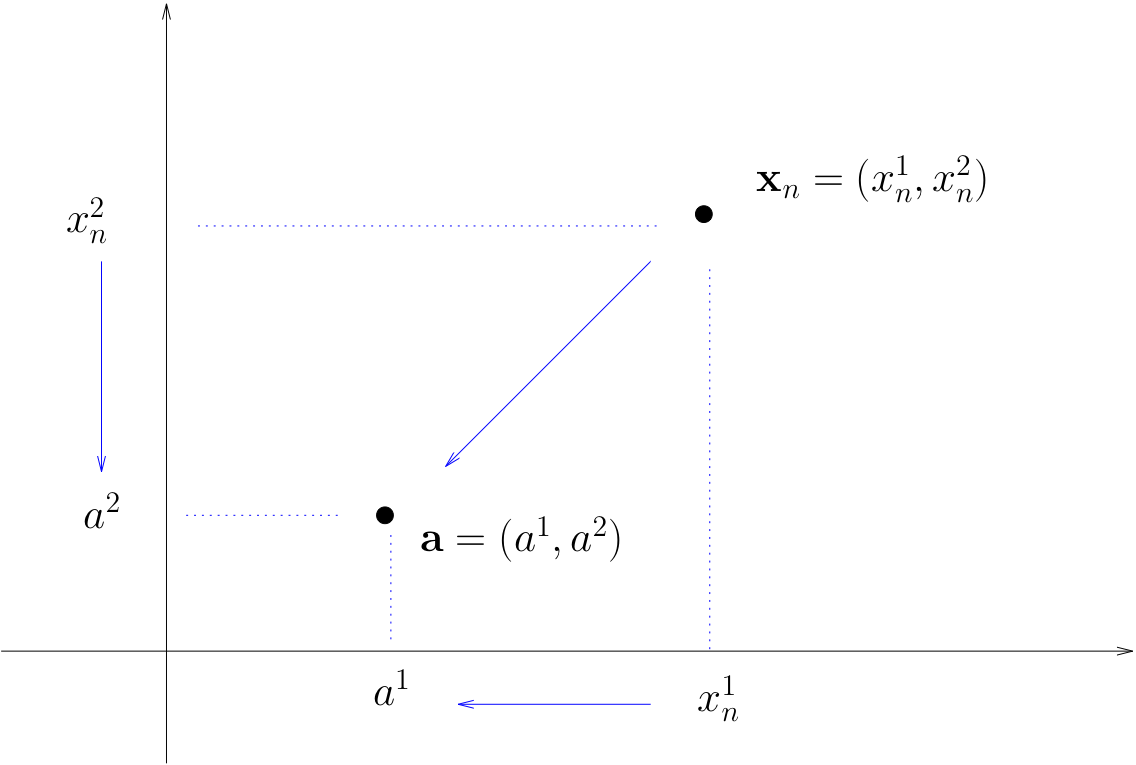
Open and Closed Sets#
Let \(G \subset \mathbb{R}^K\)
Definition
We call \({\bf x} \in G\) interior to \(G\) if \(\exists \; \epsilon > 0\) with \(B_\epsilon({\bf x}) \subset G\)
Loosely speaking, interior means “not on the boundary”
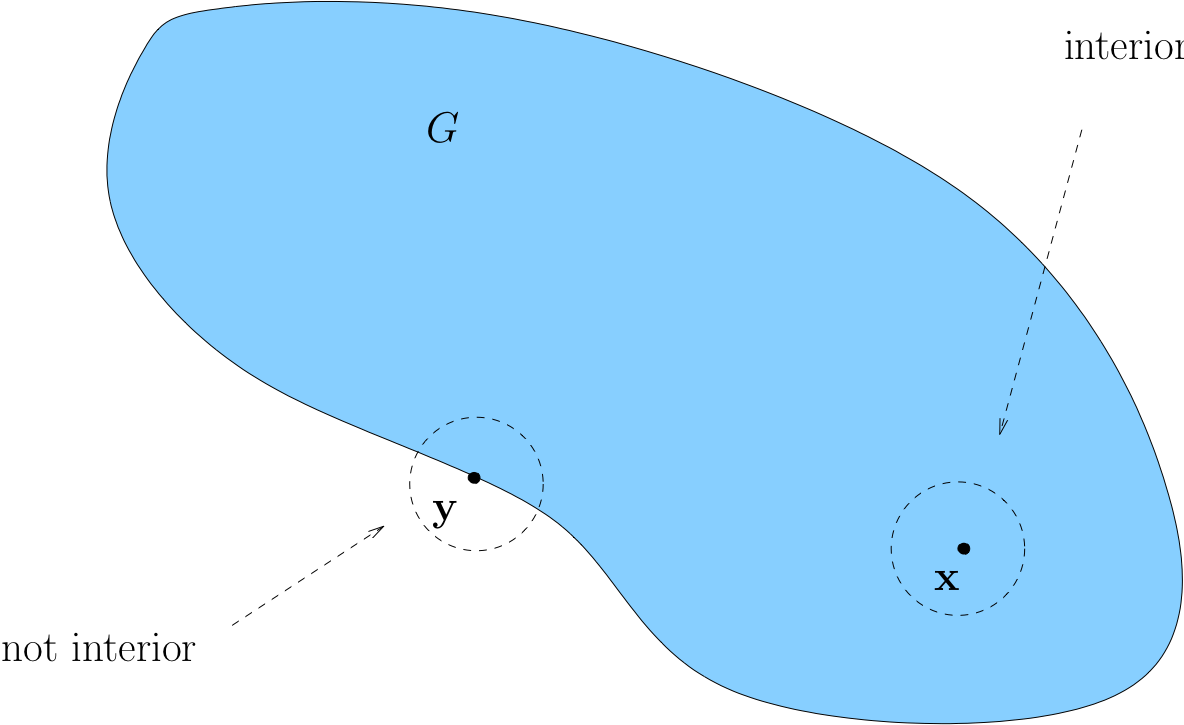
Example
If \(G = (a, b)\) for some \(a < b\), then any \(x \in (a, b)\) is interior

Proof
Fix any \(a < b\) and any \(x \in (a, b)\)
Let \(\epsilon := \min\{x - a, b - x\}\)
If \(y \in B_\epsilon(x)\) then \(y < b\) because
Example
If \(G = [-1, 1]\), then \(1\) is not interior

Intuitively, any \(\epsilon\)-ball centered on \(1\) will contain points \(> 1\)
More formally, pick any \(\epsilon > 0\) and consider \(B_\epsilon(1)\)
There exists a \(y \in B_\epsilon(1)\) such that \(y \notin [-1, 1]\)
For example, consider the point \(y := 1 + \epsilon/2\)
Exercise: Check this point: lies in \(B_\epsilon(1)\) but not in \([-1, 1]\)
Definition
A set \(G\subset \mathbb{R}^K\) is called open if all of its points are interior
Example
Open sets:
any “open” interval \((a,b) \subset \mathbb{R}\), since we showed all points are interior
any “open” ball \(B_\epsilon({\bf a}) = {\bf x} \in \mathbb{R}^K : \|{\bf x} - {\bf a} \| < \epsilon\)
\(\mathbb{R}^K\) itself
Example
Sets that are not open
\((a,b]\) because \(b\) is not interior
\([a,b)\) because \(a\) is not interior
Closed Sets#
Definition
A set \(F \subset \mathbb{R}^K\) is called closed if every convergent sequence in \(F\) converges to a point in \(F\)
Rephrased: If \(\{{\bf x}_n\} \subset F\) and \({\bf x}_n \to {\bf x}\) for some \({\bf x} \in \mathbb{R}^K\), then \({\bf x} \in F\)
Example
All of \(\mathbb{R}^K\) is closed because every sequence converging to a point in \(\mathbb{R}^K\) converges to a point in \(\mathbb{R}^K\)… right?
Example
If \((-1, 1) \subset \mathbb{R}\) is {\bf not} closed
Proof
True because
\(x_n := 1-1/n\) is a sequence in \((-1, 1)\) converging to \(1\),
and yet \(1 \notin (-1, 1)\)
Example
If \(F = [a, b] \subset \mathbb{R}\) then \(F\) is closed in \(\mathbb{R}\)
Proof
Take any sequence \(\{x_n\}\) such that
\(x_n \in F\) for all \(n\)
\(x_n \to x\) for some \(x \in \mathbb{R}\)
We claim that \(x \in F\)
Recall that (weak) inequalities are preserved under limits:
\(x_n \leq b\) for all \(n\) and \(x_n \to x\), so \(x \leq b\)
\(x_n \geq a\) for all \(n\) and \(x_n \to x\), so \(x \geq a\)
therefore \(x \in [a, b] =: F\)
Example
Any “hyperplane” of the form
is closed
Proof
Fix \({\bf a} \in \mathbb{R}^K\) and \(c \in \mathbb{R}\) and let \(H\) be as above
Let \(\{{\bf x}_n\} \subset H\) with \({\bf x}_n \to {\bf x} \in \mathbb{R}^K\)
We claim that \({\bf x} \in H\)
Since \({\bf x}_n \in H\) and \({\bf x}_n \to {\bf x}\) we have
Properties of Open and Closed Sets#
Fact
\(G \subset \mathbb{R}^K\) is open \(\iff \; G^c\) is closed
Proof
\(\implies\)
First prove necessity
Pick any \(G\) and let \(F := G^c\)
Suppose to the contrary that \(G\) is open but \(F\) is not closed, so
\(\exists\) a sequence \(\{{\bf x}_n\} \subset F\) with limit \({\bf x} \notin F\)
Then \({\bf x} \in G\), and since \(G\) open, \(\exists \, \epsilon > 0\) such that \(B_\epsilon({\bf x}) \subset G\)
Since \({\bf x}_n \to {\bf x}\) we can choose an \(N \in \mathbb{N}\) with \({\bf x}_N \in B_\epsilon({\bf x})\)
This contradicts \({\bf x}_n \in F\) for all \(n\)
\(\Longleftarrow\)
Next prove sufficiency
Pick any closed \(F\) and let \(G := F^c\), need to prove that \(G\) is open
Suppose to the contrary that \(G\) is not open
Then exists some non-interior \({\bf x} \in G\), that is no \(\epsilon\)-ball around \(x\) lies entirely in \(G\)
Then it is possible to find a sequence \(\{{\bf x}_n\}\) which converges to \(x \in G\), but every element of which lies in the \(B_{1/n}({\bf x}) \cap F\)
This contradicts the fact that \(F\) is closed
Example
Any singleton \(\{ {\bf x} \} \subset \mathbb{R}^K\) is closed
Proof
Let’s prove this by showing that \(\{{\bf x}\}^c\) is open
Pick any \({\bf y} \in \{{\bf x}\}^c\)
We claim that \({\bf y}\) is interior to \(\{{\bf x}\}^c\)
Since \({\bf y} \in \{{\bf x}\}^c\) it must be that \({\bf y} \ne {\bf x}\)
Therefore, exists \(\epsilon > 0\) such that \(B_\epsilon({\bf y}) \cap B_\epsilon({\bf x}) = \emptyset\)
In particular, \({\bf x} \notin B_\epsilon({\bf y})\), and hence \(B_\epsilon({\bf y}) \subset \{{\bf x}\}^c\)
Therefore \({\bf y}\) is interior as claimed
Since \({\bf y}\) was arbitrary it follows that \(\{{\bf x}\}^c\) is open and \(\{{\bf x}\}\) is closed
Fact
Any union of open sets is open
Any intersection of closed sets is closed
Proof
Proof of first fact:
Let \(G := \cup_{\lambda \in \Lambda} G_\lambda\), where each \(G_\lambda\) is open
We claim that any given \({\bf x} \in G\) is interior to \(G\)
Pick any \({\bf x} \in G\)
By definition, \({\bf x} \in G_\lambda\) for some \(\lambda\)
Since \(G_\lambda\) is open, \(\exists \, \epsilon > 0\) such that \(B_\epsilon({\bf x}) \subset G_\lambda\)
But \(G_\lambda \subset G\), so \(B_\epsilon({\bf x}) \subset G\) also holds
In other words, \({\bf x}\) is interior to \(G\)
But be careful:
An infinite intersection of open sets is not necessarily open
An infinite union of closed sets is not necessarily closed
For example, if \(G_n := (-1/n, 1/n)\), then \(\cap_{n \in \mathbb{N}} G_n = \{0\} \)
To see this, suppose that \(x \in \cap_n G_n\)
Then
Therefore \(x = 0\), and hence \(x \in \{0\}\)
On the other hand, if \(x \in \{0\}\) then \(x \in \cap_n G_n\)
Fact
If \(A\) is closed and bounded then every sequence in \(A\) has a subsequence which converges to a point of \(A\)
Take any sequence \(\{{\bf x}_n\}\) contained in \(A\)
Since \(A\) is bounded, \(\{{\bf x}_n\}\) is bounded
Therefore it has a convergent subsequence
Since the subsequence is also contained in \(A\), and \(A\) is closed, the limit must lie in \(A\).
Definition
Bounded and closed sets are called compact sets or compacts
Continuity#
One of the most fundamental properties of functions
Related to existence of
optima
roots
fixed points
etc
as well as a variety of other useful concepts
Reminder on functions >>#
Definition
A function \(f \colon A \rightarrow B\) from set \(A\) to set \(B\) is a rule that associates to each element of \(A\) a uniquely determined element of \(B\)

\(A\) is called the domain of \(f\) and \(B\) is called the codomain

Lower panel: functions have to map all elements in domain to a uniquely determined element in codomain.
Definition
The smallest possible codomain is called the range of \(f \colon A \to B\):
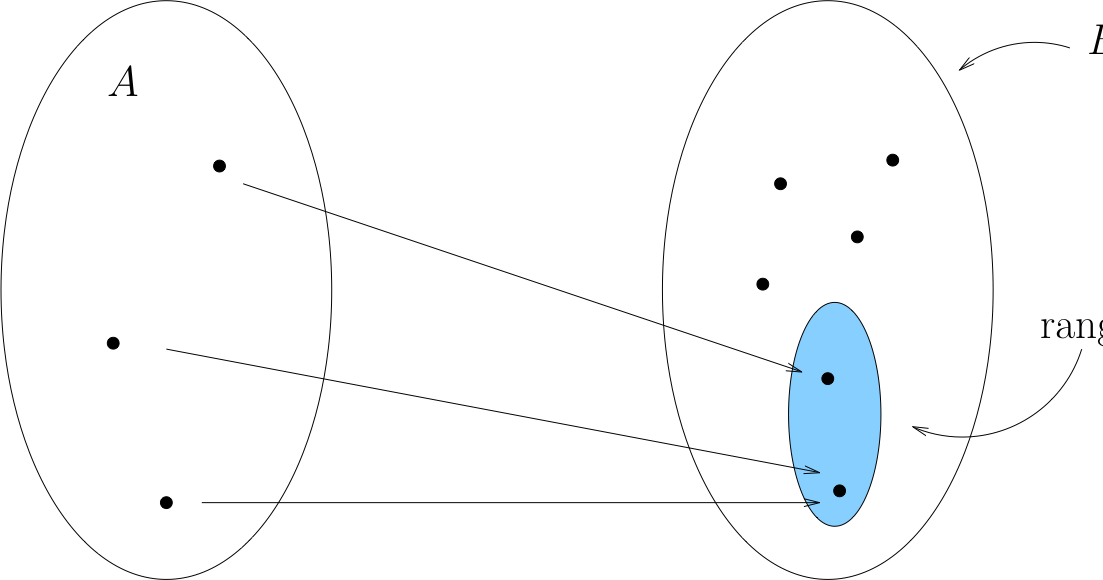
Definition
A function \(f \colon A \to B\) is called onto (or surjection) if every element of \(B\) is the image under \(f\) of at least one point in \(A\).
A function \(f \colon A \to B\) is called one-to-one (or injection) if distinct elements of \(A\) are always mapped into distinct elements of \(B\).
A function that is both one-to-one (injection) and onto (surjection) is called a bijection or one-to-one correspondence
Fact
If \(f \colon A \to B\) is one-to-one, then \(f \colon A \to \mathrm{rng}(f)\) is a bijection
Fact
If \(f \colon A \to B\) a bijection, then there exists a unique function \(\phi \colon B \to A\) such that
That function \(\phi\) is called the inverse of \(f\) and written \(f^{-1}\)

Bounded functions#
Definition
A function \(F\) is called bounded if its range is a bounded set.
Fact
If \(F\) and \(G\) are bounded, then so are \(F+G\), \(F \cdot G\) and \(\alpha F\) for any finite \(\alpha\)
Proof
Proof for the case \(F + G\):
Let \(F\) and \(G\) be bounded functions
\(\exists\) \(M_F\) and \(M_G\) s.t. \(\| F({\bf x}) \| \leq M_F\) and \(\| G({\bf x}) \| \leq M_G\) for all \({\bf x}\)
Fix any \({\bf x}\) and let \(M := M_F + M_G\)
Applying the triangle inequality gives
Since \({\bf x}\) was arbitrary this bound holds for all \({\bf x}\)
Continuous functions#
Definition
Let \(F \colon A \to \mathbb{R}^J\) where \(A\) is a subset of \(\mathbb{R}^K\). \(F\) is called continuous at \({\bf x} \in A\) if as \(n \to \infty\)
Requires that
\(F({\bf x}_n)\) converges for each choice of \({\bf x}_n \to {\bf x}\),
The limit is always the same, and that limit is \(F({\bf x})\)
Definition
\(F\) is called continuous if it is continuous at every \({\bf x} \in A\)

Fig. 73 Continuity#
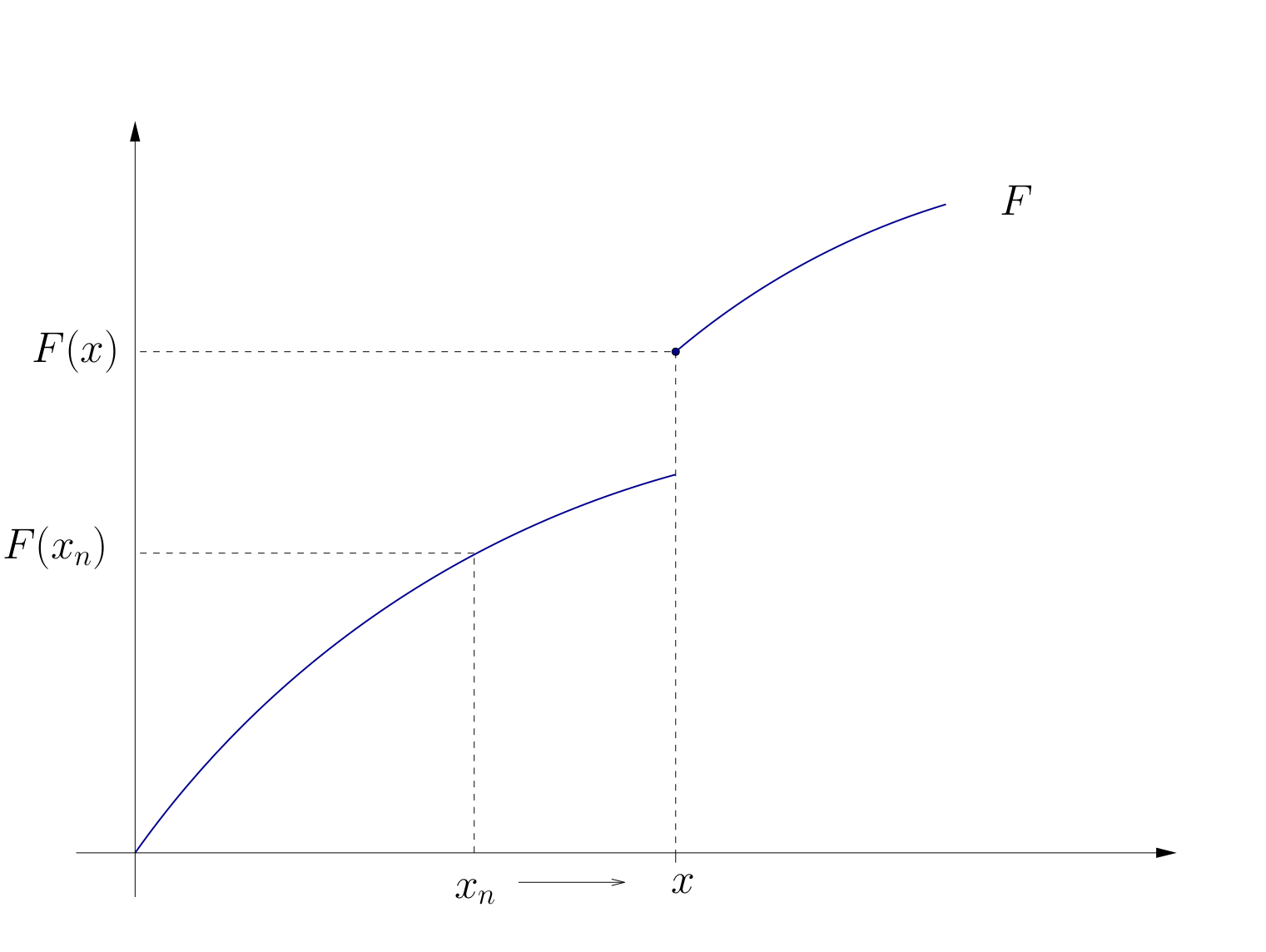
Fig. 74 Discontinuity at \(x\)#
Example
Let \({\bf A}\) be an \(J \times K\) matrix and let \(F({\bf x}) = {\bf A} {\bf x}\)
The function \(F\) is continuous at every \({\bf x} \in \mathbb{R}^K\)
To see this take
any \({\bf x} \in \mathbb{R}^K\)
any \({\bf x}_n \to {\bf x}\)
By the definition of the matrix norm \(\| {\bf A} \|\), we have
Exercise: Exactly what rules are we using here?
Fact
If \(f \colon \mathbb{R} \to \mathbb{R}\) is differentiable at \(x\), then \(f\) is continuous at \(x\)
Fact
Some functions known to be continuous on their domains:
\(x \mapsto x^\alpha\)
\(x \mapsto |x|\)
\(x \mapsto \log(x)\)
\(x \mapsto \exp(x)\)
\(x \mapsto \sin(x)\)
\(x \mapsto \cos(x)\)
Example
Discontinuous at zero: \(x \mapsto \mathbb{1}\{x > 0\}\).
Fact
Let \(F\) and \(G\) be functions and let \(\alpha \in \mathbb{R}\)
If \(F\) and \(G\) are continuous at \({\bf x}\) then so is \(F + G\), where
If \(F\) is continuous at \({\bf x}\) then so is \(\alpha F\), where
If \(F\) and \(G\) are continuous at \({\bf x}\) and real valued then so is \(FG\), where
In the latter case, if in addition \(G({\bf x}) \ne 0\), then \(F/G\) is also continuous.
As a result, set of continuous functions is “closed” under elementary arithmetic operations
Example
The function \(F \colon \mathbb{R} \to \mathbb{R}\) defined by
is continuous
Proof
Just repeatedly apply the rules on the previous slide
Let’s just check that
Let \(F\) and \(G\) be continuous at \({\bf x}\)
Pick any \({\bf x}_n \to {\bf x}\)
We claim that \(F({\bf x}_n) + G({\bf x}_n) \to F({\bf x}) + G({\bf x})\)
By assumption, \(F({\bf x}_n) \to F({\bf x})\) and \(G({\bf x}_n) \to G({\bf x})\)
From this and the triangle inequality we get
End of review, new topic next >>>
Suprema and Infima (\(\mathrm{sup}\) + \(\mathrm{inf}\))#
In the introductory lecture we have seen a few simple examples of optimization problems. Like in many introductory econ/finance cources we get well behaved, prepackaged problems.
Usually they
have a solution
the solution is unique and not hard to find
However, for the majority of problems such properties aren’t guaranteed
We need some idea of how to check these things
Consider the problem of finding the “maximum” or “minimum” of a function
A first issue is that such values might not be well defined
Recall that the set of maximizers/minimizers can be
empty
a singleton (contains one element)
infinite (contains infinitely many elements)
Show code cell content
from myst_nb import glue
import matplotlib.pyplot as plt
import numpy as np
def subplots():
"Custom subplots with axes through the origin"
fig, ax = plt.subplots()
# Set the axes through the origin
for spine in ['left', 'bottom']:
ax.spines[spine].set_position('zero')
for spine in ['right', 'top']:
ax.spines[spine].set_color('none')
return fig, ax
xmin, xmax = 0, 1
xgrid1 = np.linspace(xmin, xmax, 100)
xgrid2 = np.linspace(xmax, 2, 10)
fig, ax = subplots()
ax.set_ylim(0, 1.1)
ax.set_xlim(-0.0, 2)
func_string = r'$f(x) = x^2$ if $x < 1$ else $f(x) = 0.5$'
ax.plot(xgrid1, xgrid1**2, 'b-', lw=3, alpha=0.6, label=func_string)
ax.plot(xgrid2, 0 * xgrid2 + 0.5, 'b-', lw=3, alpha=0.6)
#ax.legend(frameon=False, loc='lower right', fontsize=16)
glue("fig_none", fig, display=False)

Example: no maximizers
The following function has no maximizers on \([0, 2]\)

Fig. 75 No maximizer on \([0, 2]\)#
This leads us to start with “suprema” and “infima”
Always well defined
Agree with max and min when the latter exist
Definition
Let \(A \subset \mathbb{R}\). A number \(u \in \mathbb{R}\) is called an upper bound of \(A\) if
Example
If \(A = (0, 1)\) then 10 is an upper bound of \(A\)
\(\because \quad\) Every element of \((0, 1)\) is \(\leq 10\)
Example
If \(A = (0, 1)\) then 1 is an upper bound of \(A\)
\(\because \quad\) Every element of \((0, 1)\) is \(\leq 1\)
Example
If \(A = (0, 1)\) then \(0.5\) is not an upper bound of \(A\)
\(\because \quad\) \(\exists\, a = 0.6 \in (0, 1) = A\) and \(0.5 < 0.6\)
Let \(U(A) :=\) set of all upper bounds of \(A\)

Examples
If \(A = [0, 1]\), then \(U(A) = [1, \infty)\)
If \(A = (0, 1)\), then \(U(A) = [1, \infty)\)
If \(A = (0, 1) \cup (2, 3)\), then \(U(A) = [3, \infty)\)
If \(A = \mathbb{N}\), then \(U(A) = \emptyset\)
Definition
The least upper bound of \(A\) is called supremum of \(A\).
In other words, if \(s\) is a number satisfying
then \(s\) is the supremum of \(A\) and we write \(s = \sup A\)

Example
If \(A = (0, 1]\), then \(U(A) = [1, \infty)\), so \(\sup A = 1\)
Example
If \(A = (0, 1)\), then \(U(A) = [1, \infty)\), so \(\sup A = 1\)
Definition
A set \(A \subset \mathbb{R}\) is called bounded above if \(U(A)\) is not empty
Fact
If \(A\) is nonempty and bounded above then \(A\) has a supremum in \(\mathbb{R}\)
Equivalent to the fact that all Cauchy sequences converge
Same principle: \(\mathbb{R}\) has no “gaps” or “holes”
What if \(A\) is not bounded above, so that \(U(A) = \emptyset\)?
We follow the convention that \(\sup A := \infty\) in this case
Now the supremum of a nonempty subset of \(\mathbb{R}\) always exists
Note
Aside: Conventions for dealing with symbols “\(\infty\)’’ and ``\(-\infty\)”
If \(a \in \mathbb{R}\), then
\(a + \infty = \infty\)
\(a - \infty = -\infty\)
\(a \times \infty = \infty\) if \(a \ne 0\), \(0 \times \infty = 0\)
\(-\infty < a < \infty\)
\(\infty + \infty = \infty\)
\(-\infty - \infty = -\infty\)
But \(\infty - \infty\) is not defined
Fact
If \(A \subset B\), then \(\sup A \leq \sup B\)

Proof
Let \(A \subset B\)
If \(\sup B = \infty\) then the claim is trivial so suppose \(\bar b = \sup B < \infty\)
By definition, \(\bar b \in U(B)\), so \(b \leq \bar b\) for all \(b \in B\)
Since each \(a \in A\) is also in \(B\), we then have \(a \leq \bar b\) for all \(a \in A \)
It follows that \(\bar b \in U(A)\)
Hence \(\sup A \leq \bar b\)
Fact
Let \(A\) be any set bounded from above and let \(s := \sup A\). There exists a sequence \(\{x_n\}\) in \(A\) with \(x_n \to s\).
Proof
Note that

(Otherwise \(s\) is not a sup, because \(s-\frac{1}{n}\) is a smaller upper bound)
The sequence \(\{x_n\}\) lies in \(A\) and converges to \(s\)
Definition
A lower bound of \(A \subset \mathbb{R}\) is any \(\ell \in \mathbb{R}\) with \(\ell \leq a\) for all \(a \in A\)
Definition
If \(i \in \mathbb{R}\) is an lower bound for \(A\) with \(i \geq \ell\) for every lower bound \(\ell\) of \(A\), then \(i\) is called the infimum of \(A\)
Infimum is written as \(i = \inf A\)
Example
If \(A = [0, 1]\), then \(\inf A = 0\)
If \(A = (0, 1)\), then \(\inf A = 0\)
Fact
Every nonempty subset of \(\mathbb{R}\) bounded from below has an infimum
If \(A\) is unbounded below then we set \(\inf A = -\infty\)
Maxima and Minima of Sets#
In optimization we’re mainly interested in maximizing and minimizing functions
As we’ll see, the problem is the same as finding the largest number in the range of \(f\)
That is, the largest number in the set
Definition
We call \(a^*\) the maximum of \(A \subset \mathbb{R}\) and write \(a^* = \max A\) if
Example
If \(A = [0, 1]\) then \(\max A = 1\)
Definition
We call \(a^*\) the minimum of \(A \subset \mathbb{R}\) and write \(a^* = \min A\) if
Example
If \(A = [0, 1]\) then \(\min A = 0\)
Fact
If \(A \subset \mathbb{R}\) is finite then \(\max A\) and \(\min A\) always exist
Example
\(\max\{2, 4, 6, 8\} = 8\)
\(\min\{2, 4, 6, 8\} = 2\)
Fact
For infinite subsets of \(\mathbb{R}\), max and min may not exist!
Example
\(\max \mathbb{N}\) does not exist
Proof
Suppose to the contrary that \(n^* = \max \mathbb{N}\)
By the definition of the maximum, \(n^* \in \mathbb{N}\)
Now consider
Clearly
This contradicts the definition of \(n^*\)
Example
\(\max (0, 1)\) does not exist
Proof
Suppose to the contrary that \(a^* = \max (0, 1)\)
By the definition of the maximum, \(a^* \in (0, 1)\)
Hence \(a^* < 1\)
Now consider
Clearly
Contradicts hypothesis that \(a^*\) is the maximum
Relationship between max/min and sup/inf#
When max and min exist they agree with sup and inf
Fact
Let \(A\) be any subset of \(\mathbb{R}\)
If \(\sup A \in A\), then \(\max A\) exists and \(\max A = \sup A\)
If \(\inf A \in A\), then \(\min A\) exists and \(\min A = \inf A\)
Proof
Proof of case 1: Let \(a^* := \sup A\) and suppose \(a^* \in A\)
We want to show that \(\max A = a^*\)
Since \(a^* \in A\), we need only show that \(a \leq a^*\) for all \(a \in A\)
This follows from \(a^* = \sup A\), which implies \(a^* \in U(A)\)
Fact
If \(F \subset \mathbb{R}\) is a closed and bounded, then \(\max F\) and \(\min F\) both exist
Proof
Proof for the max case:
Since \(F\) is bounded,
\(\sup F\) exists
\(\exists\) a sequence \(\{x_n\} \subset F\) with \(x_n \to \sup F\)
Since \(F\) is closed, this implies that \(\sup F \in F\)
Hence \(\max F\) exists and \(\max F = \sup F\)
Existence of optima for functions#
Now we turn to suprema and infima, maxima and minima (extrema) for functions
This is not a new concept — it’s just about extrema of sets — but the sets are the range of functions
In particular
The sup of a function \(f\) is just the sup of its range
The max of a function \(f\) is just the max of its range
Througout we use the notation
Definition
Let \(f \colon A \to \mathbb{R}\), where \(A\) is any set
The supremum of \(f\) on \(A\) is defined as
The infimum of \(f\) on \(A\) is defined as
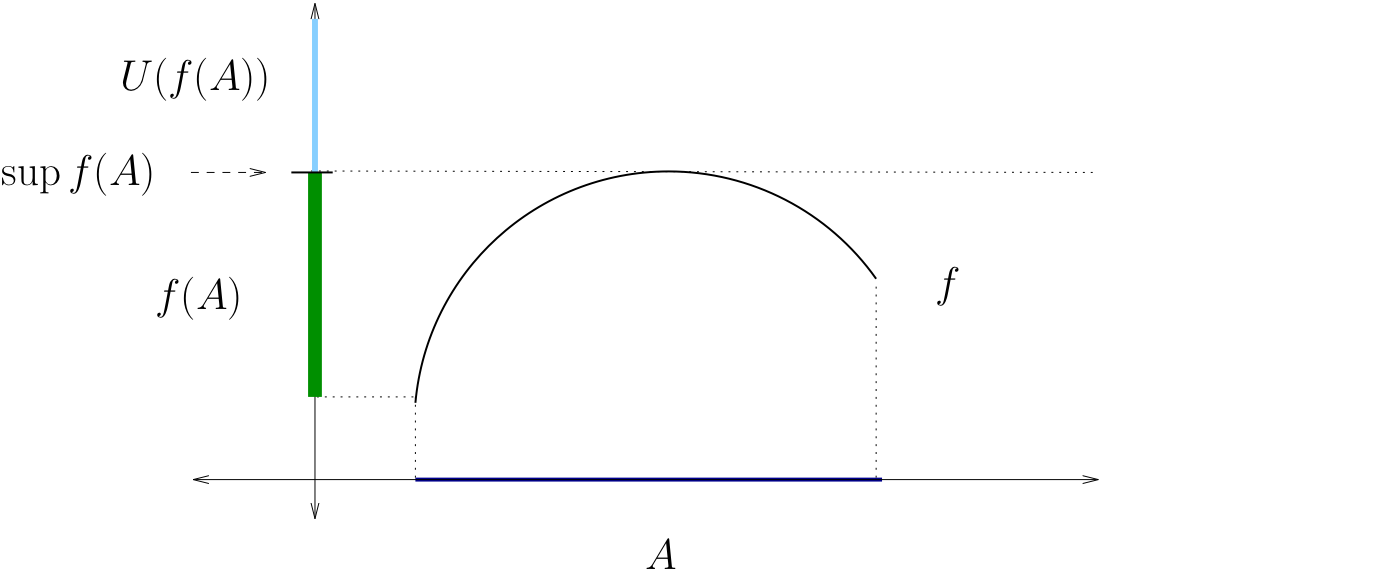
Fig. 76 The supremum of \(f\) on \(A\)#
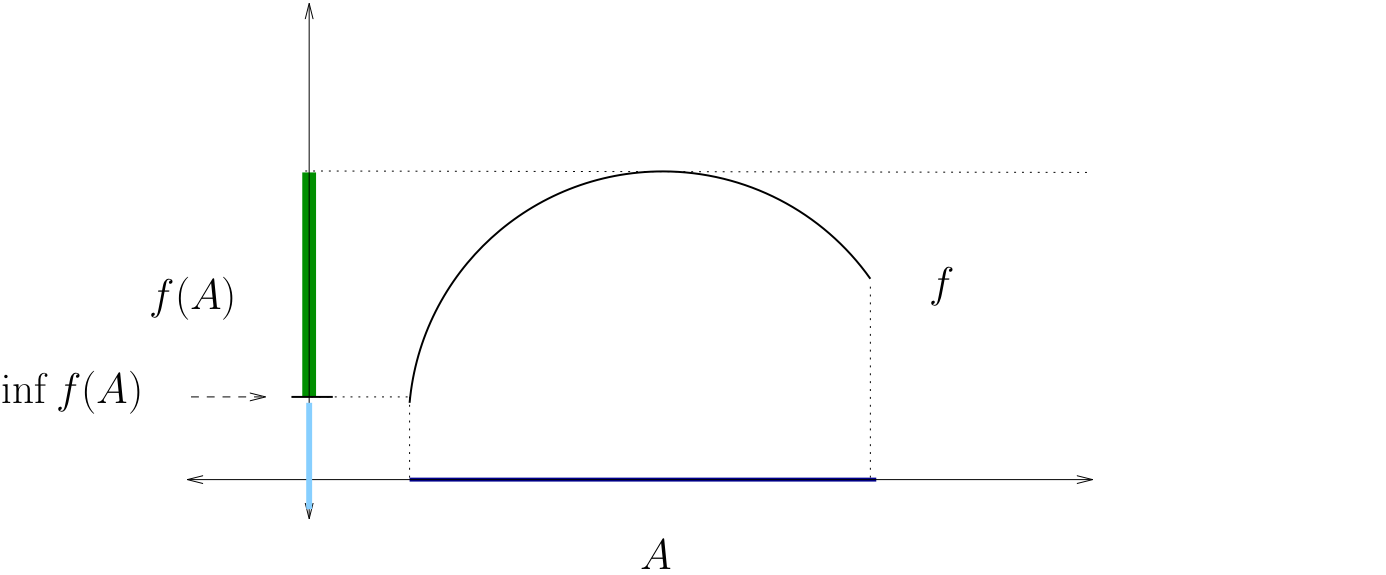
Fig. 77 The infimum of \(f\) on \(A\)#
Definition
Let \(f \colon A \to \mathbb{R}\) where \(A\) is any set
The maximum of \(f\) on \(A\) is defined as
The minimum of \(f\) on \(A\) is defined as
Definition
A maximizer of \(f\) on \(A\) is a point \({\bf a}^* \in A\) such that
or equivalently
The set of all maximizers is typically denoted by
Definition
A minimizer of \(f\) on \(A\) is a point \({\bf a}^* \in A\) such that
or equivalently
The set of all minimizers denoted by
Weierstrass extreme value theorem#
Fact (Weierstrass extreme value theorem)
If \(f\) is continuous and \(A\) is closed and bounded, then \(f\) has both a maximizer and a minimizer in \(A\).
Proof
Sketch:
can show under the assumptions that \(f(A)\) is closed and bounded
proof uses Bolzano–Weierstrass theorem, details omitted
Hence the max of \(f(A)\) exists, and we can write
The point \({\bf x}^* \in A\) such that \(f({\bf x}^*) = M^*\) is a maximizer
Example
Consider the problem
where
\(r=\) interest rate, \(w=\) wealth, \(\beta=\) discount factor
all parameters \(> 0\)
Let \(B\) be all \((c_1, c_2)\) satisfying the constraint
Exercise: Show that the budget set \(B\) is a closed, bounded subset of \(\mathbb{R}^2\)
Exercise: Show that \(U\) is continuous on \(B\)
We conclude that a maximizer exists
Properties of Optima#
We now state some useful facts regarding optima
Sometimes we state properties about sups and infs rather than max and min — this is so we don’t have to keep saying “if it exsits”
But remember that if it does exist then the same properties apply: if a max exists, then it’s a sup, etc.
Fact
If \(A \subset B\) and \(f \colon B \to \mathbb{R}\), then
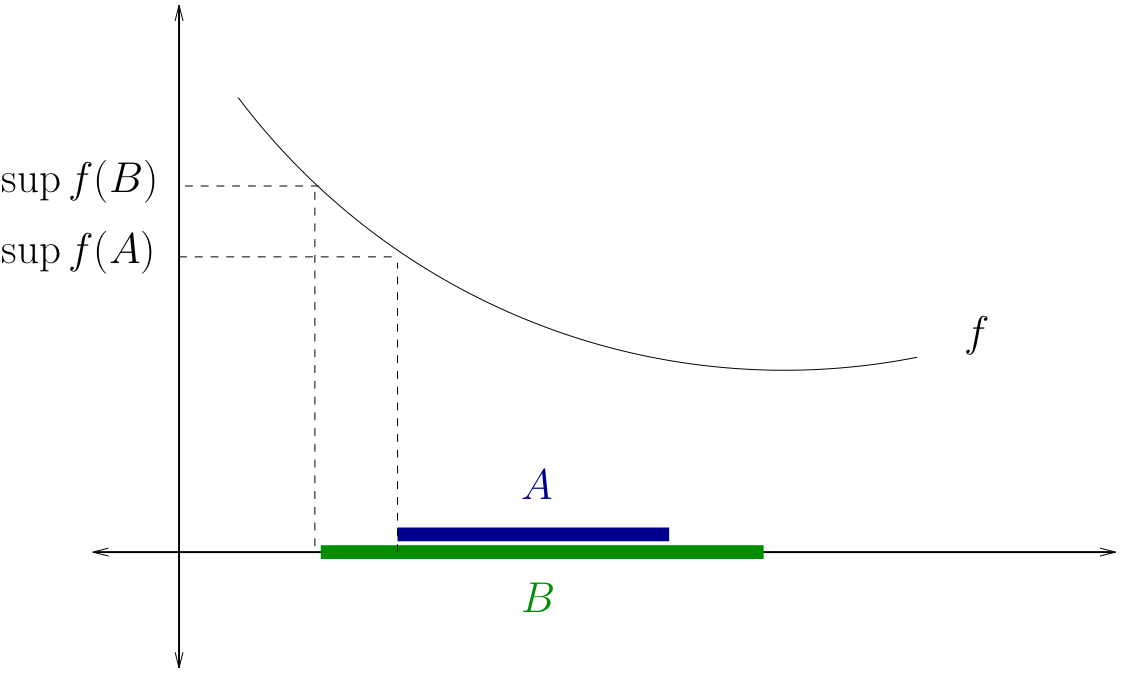
Proof
Proof, for the sup case:
Let \(A\), \(B\) and \(f\) be as in the statement of the fact
We already know that \(C \subset D \implies \sup C \leq \sup D\)
Hence it suffices to show that \(f(A) \subset f(B)\), because then
To see that \(f(A) \subset f(B)\), take any \(y \in f(A)\)
By definition, \(\exists \, {\bf x} \in A\) such that \(f({\bf x}) = y\)
Since \(A \subset B\) we must have \({\bf x} \in B\)
So \(f({\bf x}) = y\) for some \({\bf x} \in B\), and hence \(y \in f(B)\)
Thus \(f(A) \subset f(B)\) as was to be shown
Example
“If you have more choice then you’re better off”
Consider the problem of maximizing utility
over all \((x_1, x_2)\) in the budget set
Thus, we solve
Clearly \(m \leq m' \implies B(m) \subset B(m')\)
Hence the maximal value goes up as \(m\) increases
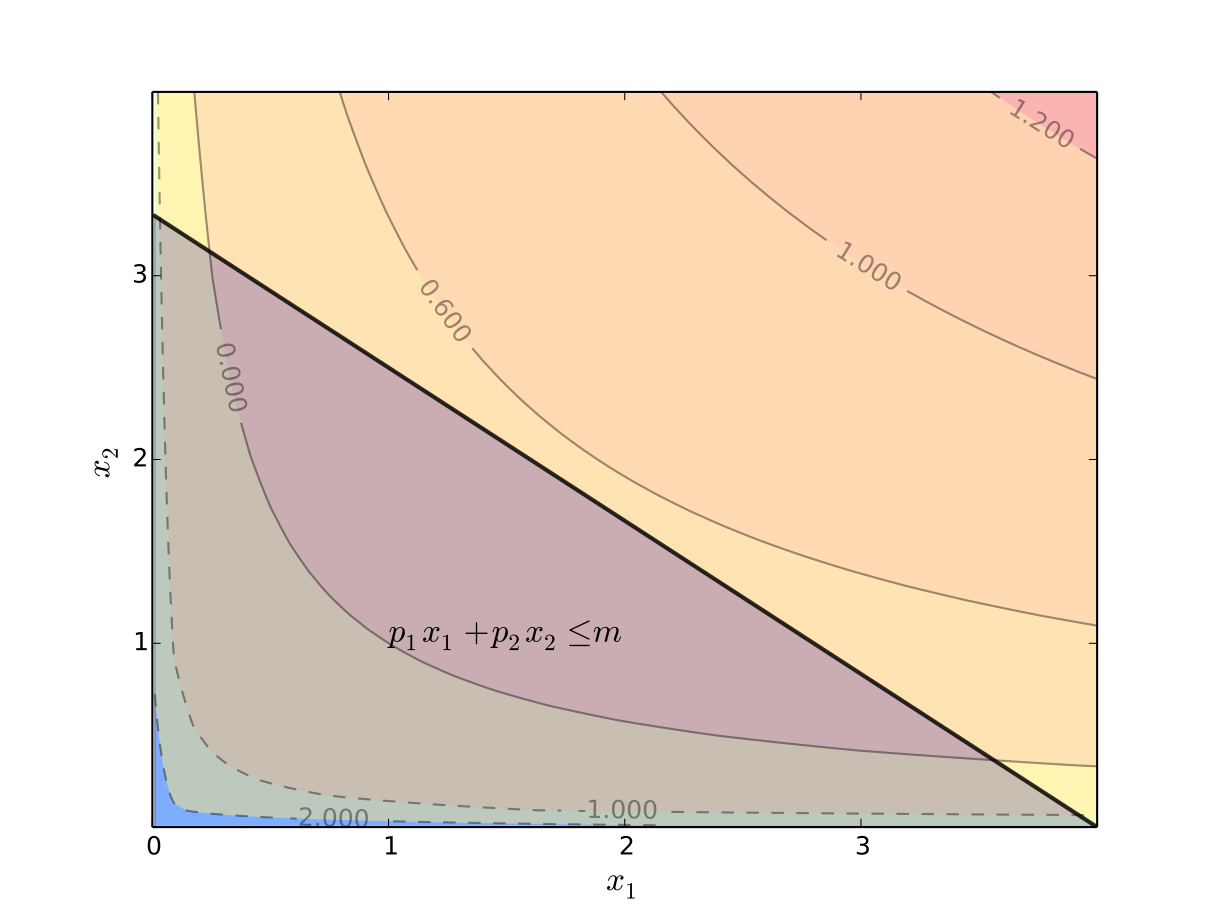
Fig. 78 Budget set \(B(m)\)#
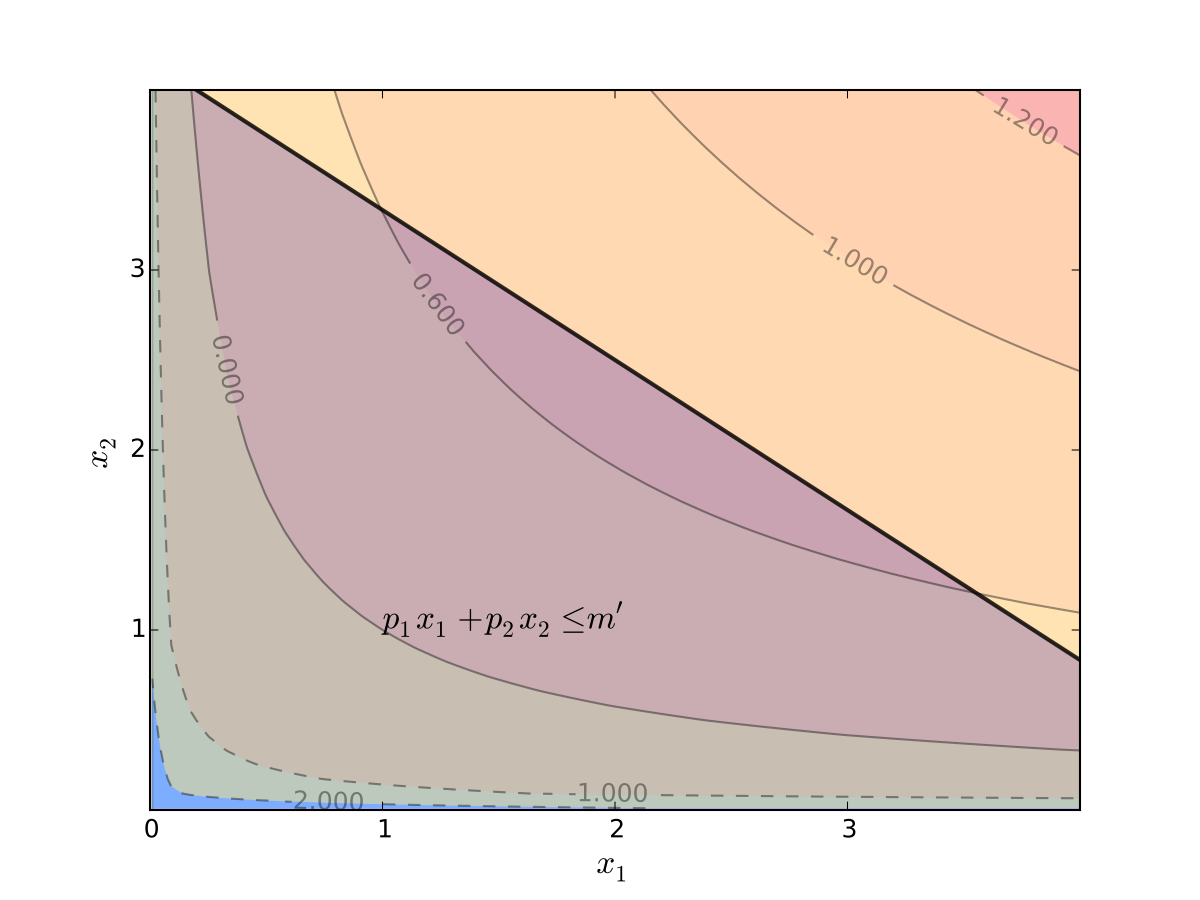
Fig. 79 Budget set \(B(m')\)#
Example
Let \(y_n\) be income and \(x_n\) be years education
Consider regressing income on education:
We have data for \(n = 1, \ldots, N\) individuals
Successful regression is often associated with large \(R^2\)
A measure of “goodness of fit”
Large \(R^2\) occurs when we have a small sum of squared residuals
However, we can always reduce the ssr by including irrelevant variables
e.g., \(z_n = \) consumption of apples in kgs per annum
Indeed, let
Then
Fact
If \(f \colon A \to \mathbb{R}\), then

Proof
Let’s prove that, when \(g = -f\),
To begin, let \({\bf a}^*\) be a maximizer of \(f\) on \(A\)
Then, for any given \({\bf x} \in A\) we have \(f({\bf a}^*) \geq f({\bf x})\)
Hence \({\bf a}^*\) is a minimizer of \(g\) on \(A\)
because the last inequality was shown for any \({\bf x} \in A\)
Example
Most numerical routines provide minimization only
Suppose we want to maximize \(f(x) = 3 \ln x - x\) on \((0, \infty)\)
We can do this by finding the minimizer of \(-f\)
from scipy.optimize import fminbound
import numpy as np
f = lambda x: 3 * np.log(x) - x
g = lambda x: -f(x) # Find min of -f
print('Maximizer of f(x) on [1,100] is x=', fminbound(g, 1, 100))
Maximizer of f(x) on [1,100] is x= 3.0000015012062393
Fact
Given \(A \subset \mathbb{R}^K\), let
\(f \colon A \to B \subset \mathbb{R}\)
\(h \colon B \to \mathbb{R}\) and \(g := h \circ f\)
If \(h\) is strictly increasing, then
Proof
Let \({\bf a}^* \in \mathrm{argmax}_{{\bf x} \in A}f({\bf x})\)
If \({\bf x} \in A\), then \(f({\bf x}) \leq f({\bf a}^*)\), and hence \(h(f({\bf x})) \leq h(f({\bf a}^*)) \quad\)
In other words, \(g({\bf x}) \leq g({\bf a}^*)\) for any \({\bf x} \in A\)
Hence \({\bf a}^* \in \mathrm{argmax}_{{\bf x} \in A} g({\bf x})\) as claimed

Fig. 80 Increasing transform \(h(x) = \exp(x/2)\) preserves the maximizer#
Example
A well known statistical problem is to maximize the likelihood of exponential distribution:
It’s easier to maximize the log-likelihood function
The unique solution
is also the unique maximiser of \(L(\lambda)\)
In the next several propositions
\(A\) is any set
\(f\) is some function from \(A\) to \(\mathbb{R}\)
\(g\) is some function from \(A\) to \(\mathbb{R}\)
To simplify notation, we define
and
Fact
Proof
Fix any such functions \(f\) and \(g\) and any \({\bf x} \in A\)
We have
Hence \(\sup g\) is an upper bound for \(\{ f({\bf x}) \colon {\bf x } \in A\}\)
Since the supremum is the least upper bound, this gives
Fact
Proof
Fix any such functions \(f\) and \(g\) and any \({\bf x} \in A\)
We have
Fact
Proof
Picking any such \(f, g\), we have
Same argument reversing roles of \(f\) and \(g\) finishes the proof
Concavity and uniqueness of optima#
Uniqueness of optima is directly connected to convexity / concavity
Convexity is a shape property for sets
Convexity and concavity are shape properties for functions
However, only one fundamental concept: convex sets
Convex Sets#
Definition
A set \(C \subset \mathbb{R}^K\) is called convex if
Remark: This is vector addition and scalar multiplication
Convexity \(\iff\) line between any two points in \(C\) lies in \(C\)
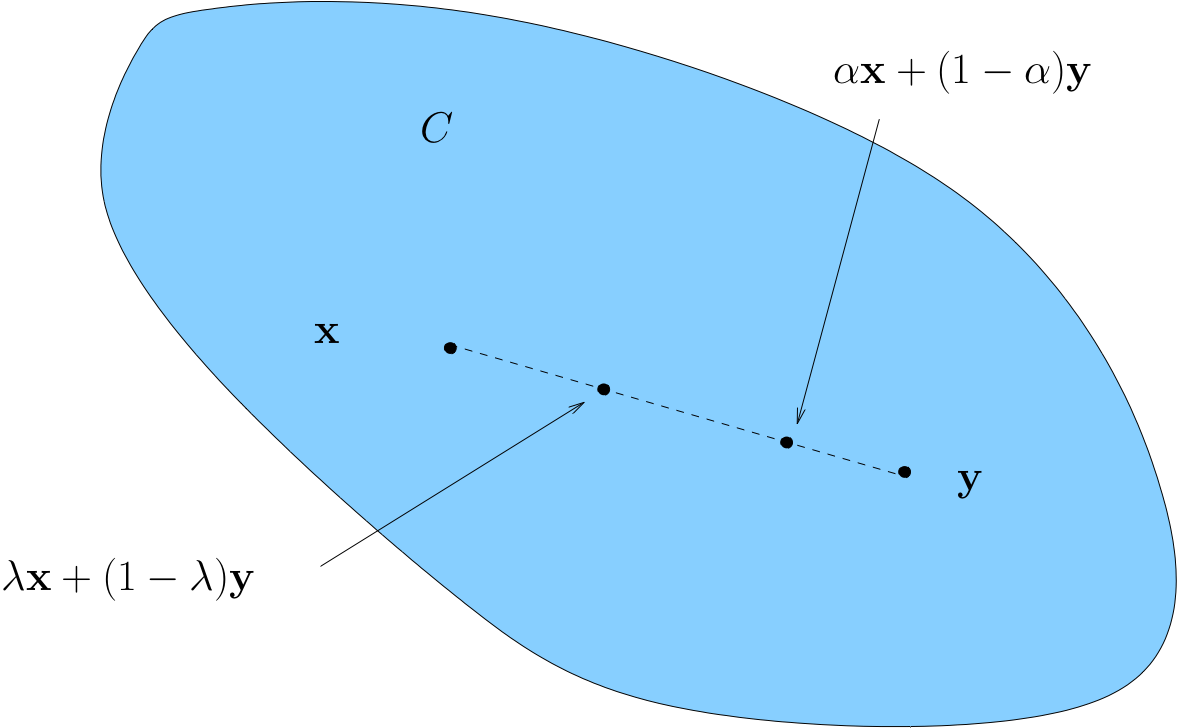
A non-convex set
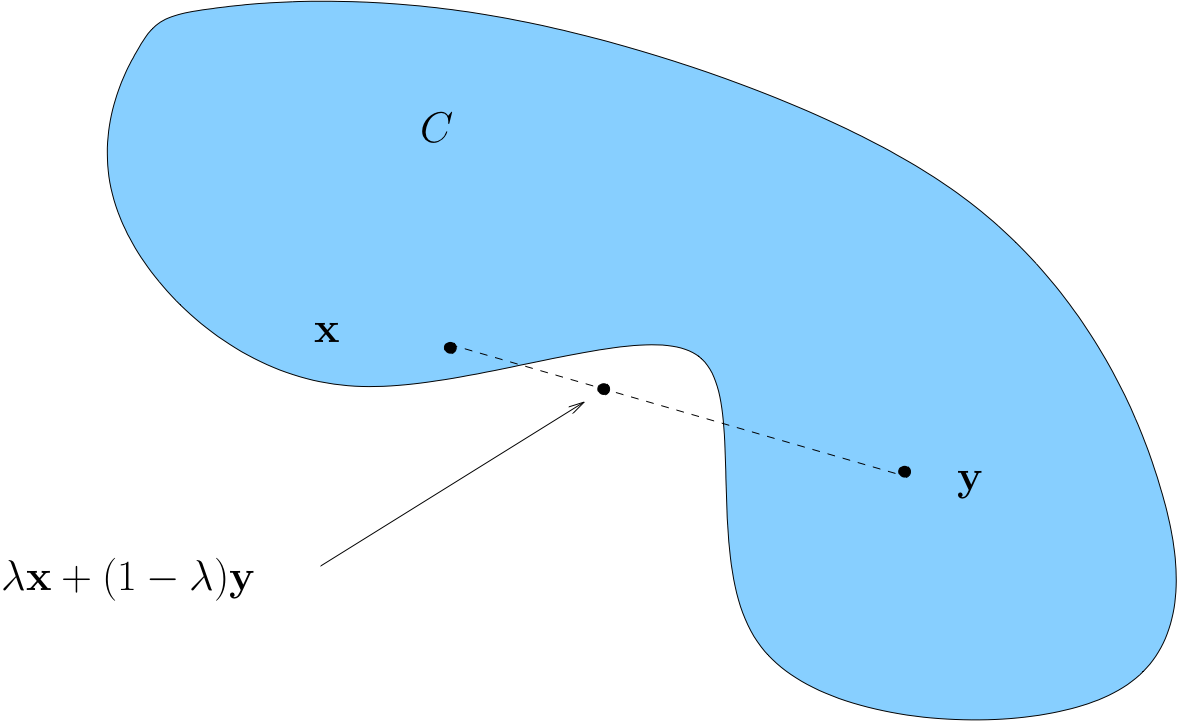
Example
The “positive cone” \(P := \{ {\bf x} \in \mathbb{R}^K \colon {\bf x } \geq {\bf 0} \}\) is convex
Proof
To see this, pick any \({\bf x}\), \({\bf y}\) in \(P\) and any \(\lambda \in [0, 1]\)
Let \({\bf z} := \lambda {\bf x} + (1 - \lambda) {\bf y}\) and let \(z_k := {\bf e}_k' {\bf z}\)
Since
\(z_k = \lambda x_k + (1 - \lambda) y_k\)
\(x_k \geq 0\) and \(y_k \geq 0\)
It is clear that \(z_k \geq 0\) for all \(k\)
Hence \({\bf z} \in P\) as claimed
Example
Every \(\epsilon\)-ball in \(\mathbb{R}^K\) is convex.
Proof
Fix \({\bf a} \in \mathbb{R}^K\), \(\epsilon > 0\) and let \(B_\epsilon({\bf a})\) be the \(\epsilon\)-ball
Pick any \({\bf x}\), \({\bf y}\) in \(B_\epsilon({\bf a})\) and any \(\lambda \in [0, 1]\)
The point \(\lambda {\bf x} + (1 - \lambda) {\bf y}\) lies in \(B_\epsilon({\bf a})\) because
Example
Let \({\bf p} \in \mathbb{R}^K\) and let \(M\) be the “half-space”
The set \(M\) is convex
Proof
Let \({\bf p}\), \(m\) and \(M\) be as described
Fix \({\bf x}\), \({\bf y}\) in \(M\) and \(\lambda \in [0, 1]\)
Then \(\lambda {\bf x} + (1 - \lambda) {\bf y} \in M\) because
Hence \(M\) is convex
Fact
If \(A\) and \(B\) are convex, then so is \(A \cap B\)
Proof
Let \(A\) and \(B\) be convex and let \(C := A \cap B\)
Pick any \({\bf x}\), \({\bf y}\) in \(C\) and any \(\lambda \in [0, 1]\)
Set
Since \({\bf x}\) and \({\bf y}\) lie in \(A\) and \(A\) is convex we have \({\bf z} \in A\)
Since \({\bf x}\) and \({\bf y}\) lie in \(B\) and \(B\) is convex we have \({\bf z} \in B\)
Hence \({\bf z} \in A \cap B\)
Example
Let \({\bf p} \in \mathbb{R}^K\) be a vector of prices and consider the budget set
The budget set \(B(m)\) is convex
Proof
To see this, note that \(B(m) = P \cap M\) where
We already know that
\(P\) and \(M\) are convex, intersections of convex sets are convex
Hence \(B(m)\) is convex
Convex Functions#
Let \(A \subset \mathbb{R}^K\) be a convex set and let \(f\) be a function from \(A\) to \(\mathbb{R}\)
Definition
\(f\) is called convex if
for all \({\bf x}, {\bf y} \in A\) and all \(\lambda \in [0, 1]\)
Definition
\(f\) is called strictly convex if
for all \({\bf x}, {\bf y} \in A\) with \({\bf x} \ne {\bf y}\) and all \(\lambda \in (0, 1)\)

Fig. 81 A strictly convex function on a subset of \(\mathbb{R}\)#
Fact
\(f \colon A \to \mathbb{R}\) is convex if and only if its epigraph (aka supergraph)
is a convex subset of \(\mathbb{R}^K \times \mathbb{R}\)
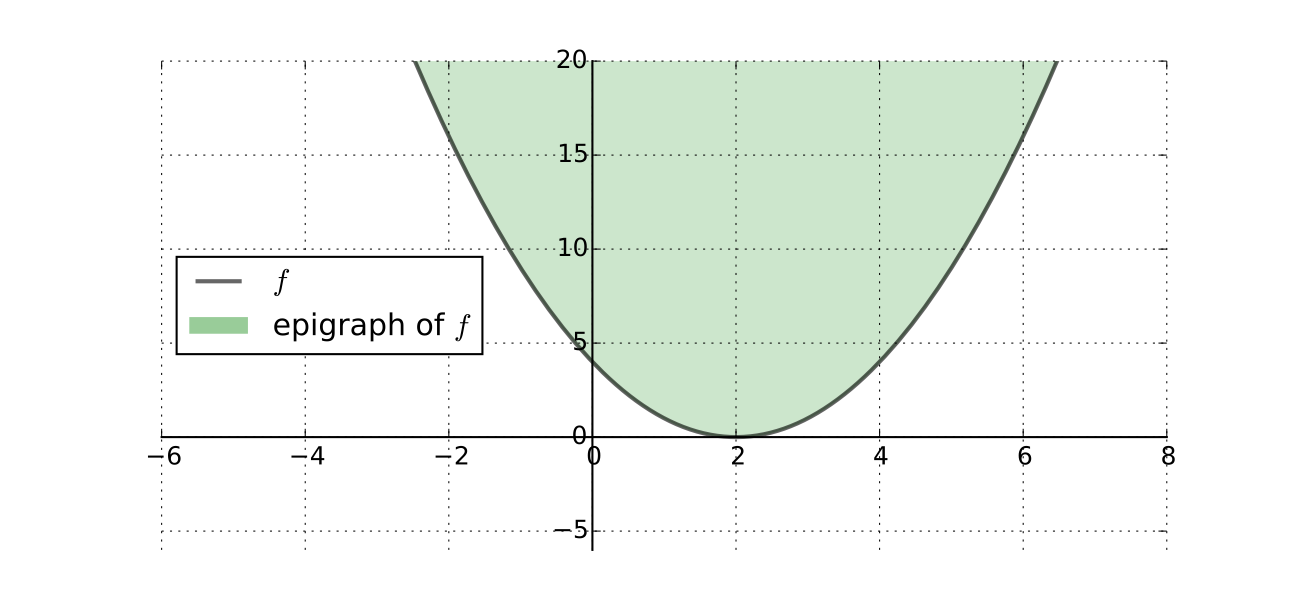

Fig. 82 A strictly convex function on a subset of \(\mathbb{R}^2\)#
Example
\(f({\bf x}) = \|{\bf x}\|\) is convex on \(\mathbb{R}^K\)
Proof
To see this recall that, by the properties of norms,
That is,
Example
\(f(x) = \cos(x)\) is not convex on \(\mathbb{R}\) because
Fact
If \({\bf A}\) is \(K \times K\) and positive definite, then
is strictly convex on \(\mathbb{R}^K\)
Proof
Proof: Fix \({\bf x}, {\bf y} \in \mathbb{R}^K\) with \({\bf x} \ne {\bf y}\) and \(\lambda \in (0, 1)\)
Exercise: Show that
Since \({\bf x} - {\bf y} \ne {\bf 0}\) and \(0 < \lambda < 1\), the right hand side is \(> 0\)
Hence
Concave Functions#
Let \(A \subset \mathbb{R}^K\) be a convex and let \(f\) be a function from \(A\) to \(\mathbb{R}\)
Definition
\(f\) is called concave if
for all \({\bf x}, {\bf y} \in A\) and all \(\lambda \in [0, 1]\)
Definition
\(f\) is called strictly concave if
for all \({\bf x}, {\bf y} \in A\) with \({\bf x} \ne {\bf y}\) and all \(\lambda \in (0, 1)\)
Exercise: Show that
\(f\) is concave if and only if \(-f\) is convex
\(f\) is strictly concave if and only if \(-f\) is strictly convex
Fact
\(f \colon A \to \mathbb{R}\) is concave if and only if its hypograph (aka subgraph)
is a convex subset of \(\mathbb{R}^K \times \mathbb{R}\)
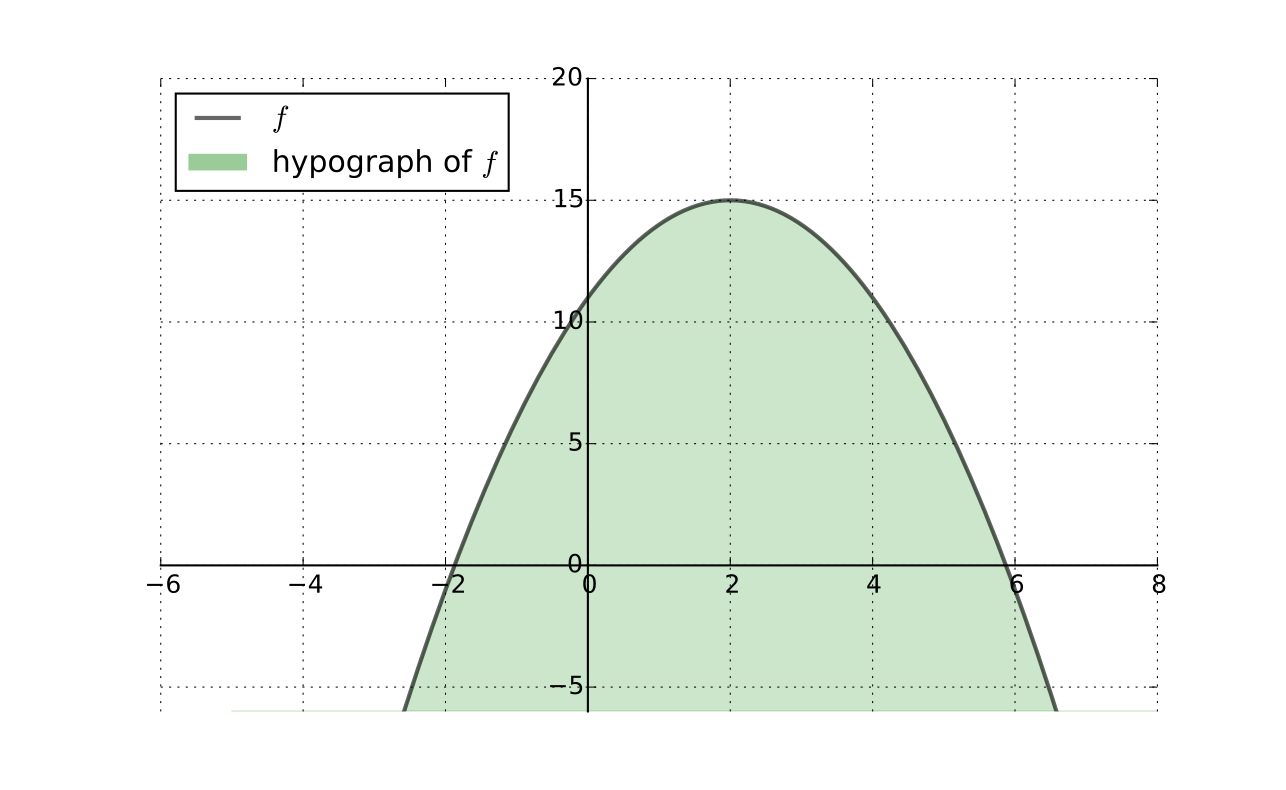
Preservation of Shape#
Let \(A \subset \mathbb{R}^K\) be convex and let \(f\) and \(g\) be functions from \(A\) to \(\mathbb{R}\)
Fact
If \(f\) and \(g\) are convex (resp., concave) and \(\alpha \geq 0\), then
\(\alpha f\) is convex (resp., concave)
\(f + g\) is convex (resp., concave)
Fact
If \(f\) and \(g\) are strictly convex (resp., strictly concave) and \(\alpha > 0\), then
\(\alpha f\) is strictly convex (resp., strictly concave)
\(f + g\) is strictly convex (resp., strictly concave)
Let’s prove that \(f\) and \(g\) convex \(\implies h := f + g\) convex
Pick any \({\bf x}, {\bf y} \in A\) and \(\lambda \in [0, 1]\)
We have
Hence \(h\) is convex
Uniqueness of Optimizers#
Fact
Let \(A \subset \mathbb{R}^K\) be convex and let \(f \colon A \to \mathbb{R}\)
If \(f\) is strictly convex, then \(f\) has at most one minimizer on \(A\)
If \(f\) is strictly concave, then \(f\) has at most one maximizer on \(A\)
Interpretation, strictly concave case:
we don’t know in general if \(f\) has a maximizer
but if it does, then it has exactly one
in other words, we have uniqueness
Proof
Proof for the case where \(f\) is strictly concave:
Suppose to the contrary that
\({\bf a}\) and \({\bf b}\) are distinct points in \(A\)
both are maximizers of \(f\) on \(A\)
By the def of maximizers, \(f({\bf a}) \geq f({\bf b})\) and \(f({\bf b}) \geq f({\bf a})\)
Hence we have \(f({\bf a}) = f({\bf b})\)
By strict concavity, then
This contradicts the assumption that \({\bf a}\) is a maximizer
A Sufficient Condition#
We can now restate more precisely optimization results stated in the introductory lectures
Let \(f \colon A \to \mathbb{R}\) be a \(C^2\) function where \(A \subset \mathbb{R}^K\) is open, convex
Recall that \({\bf x}^* \in A\) is a stationary point of \(f\) if
Fact
If \(f\) and \(A\) are as above and \({\bf x}^* \in A\) is stationary, then
\(f\) strictly concave \(\implies\) \({\bf x}^*\) is the unique maximizer of \(f\) on \(A\)
\(f\) strictly convex \(\implies\) \({\bf x}^*\) is the unique minimizer of \(f\) on \(A\)

